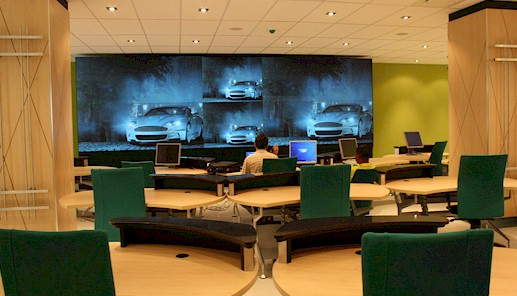02May
ZAIN COMMAND CENTRE, LUSAKA, ZAMBIA
When Celtel, a telecommunications network company, designed and planned their new head office in Lusaka, Zambia, it was also the right time to install the latest equipment for their command and control centre. This new building also included a new infra-structure for the company.

Venture Comms contacted Electrosonic SA toward the end of 2007 with the initial brief from Celtel. The brief was a system where Celtel could monitor the local network and the call centre and a videowall was not part of the original design.
Electrosonic then proposed a videowall for monitoring purposes as that is the best way to monitor a number of different computer images on a large display. The Client as well as Venture Comms was invited to visit the Gauteng Disaster Management Centre, where a 4x3 52' video cube wall was installed. The Client was excited after the visit and Electrosonic was asked to design a system for the command centre.
During the installation and commissioning period, Zain Group re-branded its entire African operations from Celtel to Zain. The name change co-incided with the linking of the world's first borderless mobile service "One Network" across two continents - Africa and Middle East.
Design
The original brief from Celtel was that they required a number of computer images to be able to be displayed on a video wall of 8 x rear projection cubes. After a team from Electrosonic visited Lusaka towards the end of last year to discuss the project in more detail with the client, it was agreed that the ideal format would be a 5 x 2 configuration for the cube wall.
The equipment list initially included 10 x SIM-2 67" videowall cubes and an Electrosonic VM Quantum processor with ancillaries, but the design and specification was later altered to include Crestron control. This decision was taken after a delegation from Celtel and Venturecomms realised how much more user-friendly the system would be with the addition of Crestron control.
In order to take full advantage of having Crestron control, Electrosonic also designed the Boardroom control system, as well as light dimming and distributed audio in the Control Room.
The primary purpose of the videowall is to monitor content from the 9 most important computers. A 10 cube configuration allows for all 9 computers to be viewed simultaneously, each on its own single display, or in any other configuration determined by the Quantum processor (see box for more information). All images may also be viewed in the Boardroom, irrespective of what is displayed in the Control Room. From his office, the Control Room Manager has the ability, via the Crestron TPS-15 touchpanel, to route signals and manipulate the scenes on the videowall.
Installation
Installing and commissioning a project of this scale requires careful planning in the best of circumstances; accomplishing it when the site is in a neighbouring country means even more stringent preparation. The Electrosonic team had to ensure that it had included every last cable and connection in the packing and shipping of the equipment. There could be no oversights; no last minute "just popping out to pick up this widget or gizmo" scenarios.
The plinth was designed and built by Electrosonic, the light dimmers were pre-wired, and the racks custom-built and assembled in Electrosonic's workshop. The team had to make sure that all the equipment, once it arrived in Zambia, worked perfectly, so a great deal of pre-testing was required. After the equipment had been shipped, an installation team of 5 Electrosonic technicians spent a week in Lusaka assembling the cube wall, pulling in and terminating cables, mounting hardware, fitting speakers, etc., to complete the installation.
Atypically, the team used Kramer fibre optic cables between the Electrosonic Quantum processor and the SIM-2 cubes, and were delighted with the result. No problems were encountered with the installation, and at the end of the week both client and supplier were satisfied that the project had been 100% successful.
All that remained was a follow-up visit to train the staff of the Command centre and some fine-tuning of the programming to accommodate a name change from Celtel to Zain.
October 2008
No video selected.

